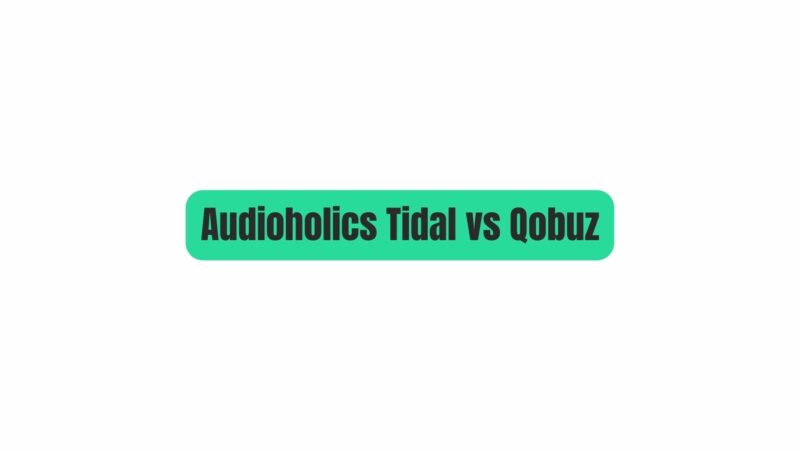The world of high-quality music streaming has evolved significantly in recent years, with audiophiles and music enthusiasts seeking platforms that deliver the best possible sound. Tidal and Qobuz have emerged as two prominent contenders in the realm of high-fidelity audio streaming. In this comprehensive article, we will provide a detailed comparison of Tidal and Qobuz, exploring their features, audio quality, catalog, pricing, and more, from the perspective of Audioholics, a trusted source for audio and home theater expertise.
Audio Quality: The Heart of the Matter
When it comes to high-fidelity streaming, audio quality is paramount. Both Tidal and Qobuz offer lossless audio, but they have some differences worth noting:
Tidal:
- Lossless FLAC Compression: Tidal streams music using lossless FLAC (Free Lossless Audio Codec) compression, ensuring that the original audio quality is preserved without any loss of data. This makes Tidal a preferred choice for audiophiles who demand the highest sound fidelity.
- CD-Quality Audio: Tidal’s standard HiFi tier provides CD-quality audio with a 44.1kHz sampling rate and a 16-bit depth. This ensures that listeners hear music exactly as intended by the artists, capturing all the nuances and details.
- Higher Bitrate Options: Tidal offers variable sampling rates for some tracks, including 48kHz, 88.2kHz, 96kHz, and even 192kHz, enhancing the audio experience for specific content.
Qobuz:
- Lossless FLAC and Hi-Res Streaming: Qobuz is renowned for its commitment to high-resolution audio streaming. It provides lossless FLAC compression and offers a comprehensive catalog of high-resolution content, including 24-bit audio at varying sampling rates.
- Extensive High-Res Library: Qobuz boasts an extensive library of high-resolution tracks, appealing to audiophiles who seek the utmost audio fidelity. It supports 24-bit audio at sampling rates up to 192kHz.
Catalog and Content: The Song Selection
The size and diversity of a streaming platform’s catalog are crucial factors for music enthusiasts. Let’s examine the catalog and content offerings of both Tidal and Qobuz:
Tidal:
- Extensive Library: Tidal offers a vast library of over 80 million tracks, spanning various genres and languages. It includes a wide range of exclusive content, live performances, and artist interviews, enhancing the overall music streaming experience.
- Tidal Masters: Tidal’s Masters tier, which includes MQA (Master Quality Authenticated) tracks, provides access to high-resolution audio and exclusive content. This tier caters to audiophiles and music enthusiasts who prioritize exceptional audio quality.
Qobuz:
- High-Resolution Focus: Qobuz is renowned for its emphasis on high-resolution audio. Its catalog includes a substantial collection of high-quality tracks, appealing to discerning listeners who demand the highest fidelity.
- Curated Playlists: Qobuz offers curated playlists and editorial content that can help users discover new music and explore their musical interests further.
Pricing and Subscription Tiers: The Budget Consideration
Pricing is a significant factor for many consumers when choosing a streaming service. Let’s compare the pricing and subscription tiers of Tidal and Qobuz:
Tidal:
- Tidal Premium: This tier offers standard-quality streaming for $9.99 per month.
- Tidal HiFi: Priced at $19.99 per month, this tier provides lossless CD-quality audio with FLAC compression.
- Tidal HiFi Plus: The top-tier option, Tidal HiFi Plus, includes lossless audio, exclusive content, and offline listening for $24.99 per month.
Qobuz:
- Studio Premier: Qobuz Studio Premier, priced at $14.99 per month, provides access to the entire catalog with lossless FLAC streaming.
- Sublime+: For $249.99 per year, Sublime+ offers Studio Premier with a discount on high-resolution purchases.
- Hi-Fi Annual: This plan offers high-resolution streaming with a 24-bit Hi-Res audio discount for $219.99 per year.
User Experience and Features: The Interface Matters
The user experience and additional features of a streaming service can significantly impact a user’s satisfaction. Let’s explore the user experience and notable features of Tidal and Qobuz:
Tidal:
- User-Friendly Interface: Tidal boasts an intuitive and user-friendly interface, making it easy to browse and discover music.
- Exclusive Content: Tidal’s exclusive content, including live performances and artist interviews, adds value to the platform.
- Offline Listening: Subscribers to Tidal HiFi and Tidal HiFi Plus can download tracks for offline listening, ideal for on-the-go listening without an internet connection.
- Tidal Masters: Tidal’s Masters tier delivers high-resolution audio and exclusive content for audiophiles.
Qobuz:
- High-Resolution Focus: Qobuz caters to audiophiles with its high-resolution audio offerings.
- Editorial Content: Qobuz provides curated playlists and editorial content to help users discover new music and explore their interests.
- Cross-Platform Compatibility: Qobuz is compatible with various devices and platforms, ensuring a seamless listening experience.
Conclusion: A Matter of Priorities
Tidal and Qobuz are both formidable contenders in the realm of high-fidelity music streaming. The choice between the two ultimately comes down to individual priorities and preferences.
Choose Tidal If:
- You seek a broad catalog with exclusive content, including live performances and artist interviews.
- High-resolution audio is essential, but you also want standard CD-quality streaming options.
- A user-friendly interface and offline listening capabilities are important.
Choose Qobuz If:
- You prioritize high-resolution audio and have a discerning ear for sound quality.
- A substantial catalog of high-quality tracks and an emphasis on editorial content appeal to you.
- You are looking for an affordable option for high-resolution audio streaming.
Ultimately, both Tidal and Qobuz cater to different aspects of the high-fidelity music streaming spectrum. Consider your audio quality preferences, budget, and content priorities to make an informed choice that aligns with your music listening needs.


